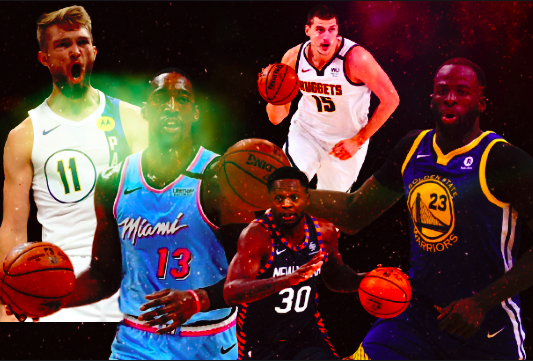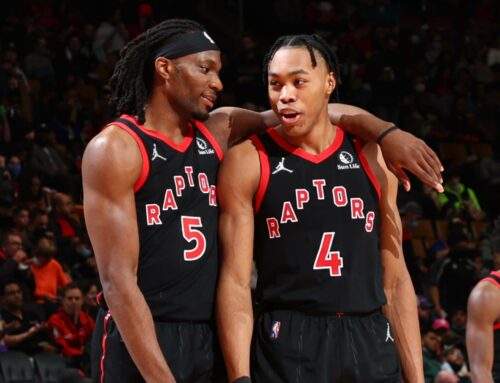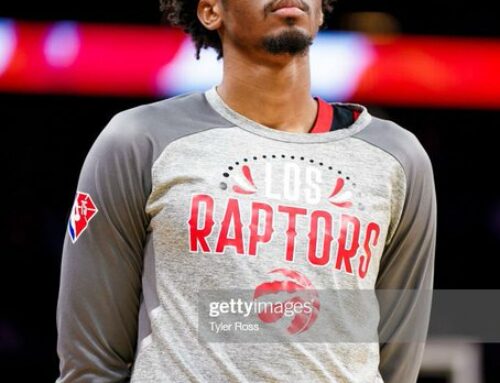The passing power forward/centre was once considered a unicorn.
An anomaly. An exception to the rule with a long explanation (that an announcer would repeat every time they played) appended to their profile.
But that was the past.
More and more, teams are running their offenses through their bigs giving them the freedom to playmake.
We aren’t talking Kevin Durant here or even Giannis Antetokounmpo. They’re major exceptions to the rule; velociraptors living in a park of antelope.
Rather, we’re looking at the classic position of a “big” once filled by hard-nosed brutes now transitioning to silky, mostly-smoothe, sometimes-brutish leviathans.
This year there are five “power forwards and two “centres” – positions are hard to classify these days – averaging more than five assists a game. Last year that total number was four and the year before five. It’s not a big difference, and it always depends on personnel (Durant and Draymond Green barely played last year). But a trend grows.
The playmaking big looks to be the newest iteration in a seemingly always evolving NBA.
It is another testament to the growth of the game and the need to be multi-faceted. Where players of all sizes (mostly big) are accruing the skillsets of other (mostly small) positions. Three-point shooting bigs were the most recent phenomenon normalized; the passing big the newest.
Five players, in particular, come to mind:
Julius Randle of the New York Knicks.
Domantas Sabonis of the Indiana Pacers.
Bam Adebayo of the Miami Heat.
Nikola Jokić of the Denver Nuggets.
Draymond Green of the Golden State Warriors.
We’ve seen glimpses of playmaking from the first three in previous years, but this season they are blossoming as true primary options.
Jokić, on the other hand, is in the process of claiming superstar rights ascending to the peak of his power; and, Dray, well Draymond is, in some ways, responsible for the style of play we see becoming commonplace – despite not being the technical “focal point” of the offense (that honour goes to his pal, Steph).
In fact, of these five guys only Draymond is outside the top fifty in the NBA in touches. Sabonis and Jokić lead the league.
Unlike their dominant predecessors, like Shaquille O’Neal or Tim Duncan or Dwight Howard or Amare Stoudemire, these new bigs are less about scoring – although most of them do a lot of that too – and more about playmaking.
All five rank in the top thirtyish in assists per game: Nikola Jokić (4th), Draymond Green (12th), Julius Randle (17th), Domantas Sabonis (27th), and Bam Adebayo (31st). Each, but Sabonis, leads their team in assists. And all of them are in the top fifty in passes made.
A decade ago Blake Griffin (excluding Boris Diaw who played more like a guard than a centre) led all bigs with 3.8 assists. And he was a “playmaker”. Marc Gasol was the closest to who these bigs have become, but even he was a more traditional post player and did little ball-handling. Things be a changin’.
Only Jokić and Sabonis post up more than 20% of the time. And even then, Jokić, while second in the league in post-ups, is much lower-ranked in paint touches, suggesting he’s “posting up” further from the basket.
Indeed each of these versatile bigs are picking teams apart in a variety of frightening ways.
1. Point-Big
All five like to handle the ball, forcing coaches into nauseating dilemmas. Either you have your slow-footed big way outside his comfort zone or you have an undersized perimeter player awaiting a manhandling.
Tell me this isn’t scary. Randle grabs a rebound and immediately rips down the court zipping by half the Cleveland Cavaliers, attacks a waif-like Dante Exum (in comparison) and then at the last second – albeit in less control than one would prefer – dumps it to Elfrid Payton for the lay-up. Need I remind you Randle is 250 lbs.
Randle is much more graceful in this clip. He takes the outlet and purposely slows his progress to let his teammates get set. Then, watching a cutting RJ Barrett grab the attention of the D, sends an overhead pass for a transition three-pointer in the corner.
2. Dribble-Hand-Offs
The dribble-hand-off is a more traditional big/guard action. Some teams, like Indiana and Miami, seem to run it over and over again through a multitude of variations. The big hovers in the high post or perimeter for guards to runaround. But newer renditions involve the big initiating the play by dribbling to the already moving cutter.
This does two things: one, it takes the momentum of the screener’s defender away from where the cutter is going to end up (either a curl or a fade) and, two, it gives the cutter’s defender little time to figure out that they are about to get bonecrushed.
Watch Sabonis, who is a meannnn man, bring the ball up the court and innocently saunter over to an already cutting Doug McDermott. My neck twinges watching the defender, Evan Fournier, unexpectedly get smashed.
Adebayo does something similar, he looks like he is going coast-to-coast until the last second where he crosses over towards a hovering Duncan Robinson clipping Joe Harris in the process.
3. Elbow Domain
Jokić, Sabonis, and Adebayo are three of the top four in elbow touches in the league. They love going to work here, which makes sense. They are a paper ball toss away from a jumper; have enough room to go to work in isolation; are central to the actions happening on or around them; and, have an ideal perspective to find the open player.
4. Face-Up Isolation
Some do it more than others. Adebayo and Randle sure like to: they both average as many isolations per game as guys like Kyrie Irving and Brandon Ingram.
Bam does it from the elbow ravaging with jabs and head fakes.
Randle dizzies all over the court using unruly handles.
5. Control Centres
I know it looks like I am putting these five guys in the same class, but Draymond and Jokić are their own specimens.
Draymond is mostly on the perimeter or in the high-high post orchestrating the Warriors offense like some overzealous citizen getting out of their car and directing traffic after a fender bender. He’s basically one of those old 90s point guards who just hefts his way around the court using his weight and quantum-level IQ to outmaneuver the other team.
This is not even really a great play. But watch Dray literally wait for Kelly Oubre and Andrew Wiggins to go where he wants them to go (and stare at them like a terribly disappointed parent). Then, after Wiggins kind of does go where he is supposed to, Dray takes the time to tell Kelly where he was supposed to go. By the way, Dray did have an easy lay-up. That’s part autocrat/part meta-mind at work.
This one is classic Dray. He literally POINTS (it’s much less dramatic than this one) to where he wants to pass Wiggins the ball. There’s like a Queen Bee-Drone relationship going on.
Jokić similarly uses his milk-bag body and brilliance to destroy opponents. But his playmaking is supreme. He is the best passer in the league. He draws players in like an imploding planet anticipating both the defender and his teammate until the precise moment to pass arises. It helps when you are a human periscope seeing over the top of everyone on the court and have a water polo cannon to whip passes around.
Witness greatness. Jokić gets the post pass swiveling the head of four different defenders and then one-hand cheesestring passes it AROUND his defender to Gary Harris in the corner for three.
For the Joker, this pass is…simple(?) But it truly exemplifies both his serenity now! patience and singular passing prowess. He is literally waterpoloing the ball back-and-forth waiting, waiting, waiting for the exact moment for the cross-pool strike. He sees Jamal Murray is open, but meditatively waits for the precise moment he has foreseen: allow for Will Barton’s cut to avoid the possibility of helpside and provide Gary an even more wide-open look.
The passing big is an absolute wonder. Not only do they nimbly run offenses like oversized Mark Jacksons. But they do so in a myriad of creative and unique ways.
Guys like Jokić and Dray are once-in-a-generation, if ever. The other three portend a new era of basketball. One that runs counter to the pace and space craze. They give rise to a new era of half-court basketball. One that honours the slower-paced, physical style their predecessors were once known for but elevated by their elegant and scintillating ability to pass the ball.





